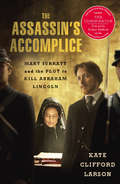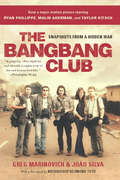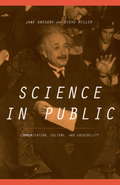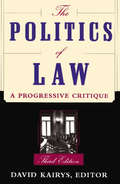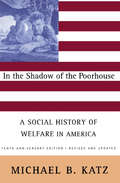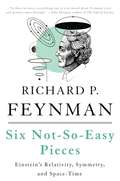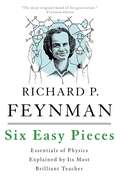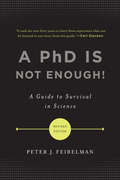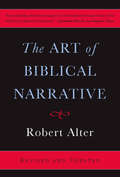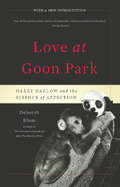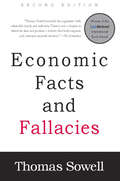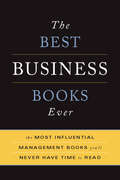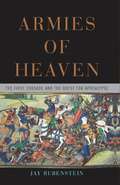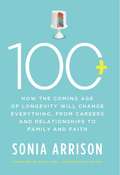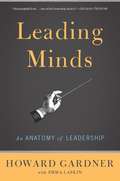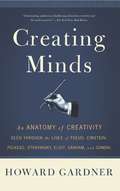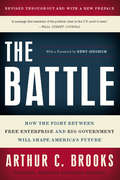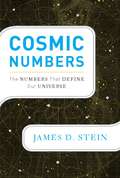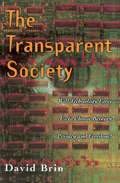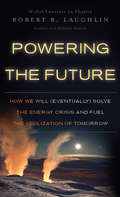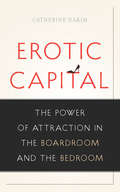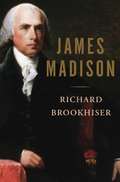- Table View
- List View
The Assassin's Accomplice: Mary Surratt and the Plot to Kill Abraham Lincoln
by Kate Clifford LarsonIn The Assassin's Accomplice, historian Kate Clifford Larson tells the gripping story of Mary Surratt, a little-known participant in the plot to kill Abraham Lincoln, and the first woman ever to be executed by the federal government of the United States. Surratt, a Confederate sympathizer, ran the boarding house in Washington where the conspirators-including her rebel son, John Surratt-met to plan the assassination. When a military tribunal convicted her for her crimes and sentenced her to death, five of the nine commissioners petitioned President Andrew Johnson to show mercy on Surratt because of her sex and age. Unmoved, Johnson refused-Surratt, he said, "kept the nest that hatched the egg.” Set against the backdrop of the Civil War, The Assassin's Accomplice tells the intricate story of the Lincoln conspiracy through the eyes of its only female participant. Based on long-lost interviews, confessions, and court testimony, the text explores how Mary's actions defied nineteenth-century norms of femininity, piety, and motherhood, leaving her vulnerable to deadly punishment historically reserved for men. A riveting narrative account of sex, espionage, and murder cloaked in the enchantments of Southern womanhood, The Assassin's Accomplice offers a fresh perspective on America's most famous murder.
The Assassin's Accomplice: Mary Surratt and the Plot to Kill Abraham Lincoln
by Kate Clifford LarsonIn The Assassin's Accomplice, historian Kate Clifford Larson tells the gripping story of Mary Surratt, a little-known participant in the plot to kill Abraham Lincoln, and the first woman ever to be executed by the federal government of the United States. Surratt, a Confederate sympathizer, ran the boarding house in Washington where the conspirators-including her rebel son, John Surratt-met to plan the assassination. When a military tribunal convicted her for her crimes and sentenced her to death, five of the nine commissioners petitioned President Andrew Johnson to show mercy on Surratt because of her sex and age. Unmoved, Johnson refused-Surratt, he said, "kept the nest that hatched the egg." Set against the backdrop of the Civil War, The Assassin's Accomplice tells the intricate story of the Lincoln conspiracy through the eyes of its only female participant. Based on long-lost interviews, confessions, and court testimony, the text explores how Mary's actions defied nineteenth-century norms of femininity, piety, and motherhood, leaving her vulnerable to deadly punishment historically reserved for men. A riveting narrative account of sex, espionage, and murder cloaked in the enchantments of Southern womanhood, The Assassin's Accomplice offers a fresh perspective on America's most famous murder.
The Bang-Bang Club, movie tie-in: Snapshots From a Hidden War
by Greg Marinovich Joao SilvaA gripping story of four remarkable young men—photographers, friends and rivals—who band together for protection in the final, violent days of white rule in South Africa.
Science In Public: Communication, Culture, And Credibility
by Jane Gregory Steven MillerDoes the general public need to understand science? And if so, is it scientists' responsibility to communicate? Critics have argued that, despite the huge strides made in technology, we live in a "scientifically illiterate" society--one that thinks about the world and makes important decisions without taking scientific knowledge into account. But is the solution to this "illiteracy" to deluge the layman with scientific information? Or does science news need to be focused around specific issues and organized into stories that are meaningful and relevant to people's lives? In this unprecedented, comprehensive look at a new field, Jane Gregory and Steve Miller point the way to a more effective public understanding of science in the years ahead.
The Politics Of Law: A Progressive Critique, Third Edition
by David KairysThe Politics of Law is the most widely read critique of the nature and role of the law in American society. This revised edition continues the book's concrete focus on the major subjects and fields of law. New essays on emerging fields and the latest trends and cases have been added to updated versions of the now-classic essays from earlier editions.A unique assortment of leading scholars and practitioners in law and related disciplines-political science, economics, sociology, criminology, history, and literature-raise basic questions about law, challenging long-held ideals like the separation of law from politics, economics, religion, and culture. They address such issues contextually and with a keen historical perspective as they explain and critique the law in a broad range of areas.This third edition contains essays on all of the subjects covered in the first year of law school while continuing the book's tradition of accessibility to non-law-trained readers. Insightful and powerful, The Politics of Law makes sense of the debates about judicial restraint and the range of legal controversies so central to American public life and culture.
In the Shadow Of the Poorhouse: A Social History Of Welfare In America, Tenth Anniversary Edition
by Michael B. KatzWith welfare reform a burning political issue, this special anniversary edition of the classic history of welfare in America has been revised and updated to include the latest bipartisan debates on how to "end welfare as we know it.”In the Shadow of the Poorhouse examines the origins of social welfare, both public and private, from the days of the colonial poorhouse through the current tragedy of the homeless. The book explains why such a highly criticized system persists. Katz explores the relationship between welfare and municipal reform; the role of welfare capitalism, eugenics, and social insurance in the reorganization of the labor market; the critical connection between poverty and politics in the rise of the New Deal welfare state; and how the War on Poverty of the '60s became the war on welfare of the '80s.
Six Not-So-Easy Pieces: Einstein's Relativity, Symmetry, and Space-Time
by Richard P. Feynman Robert B. Leighton Matthew SandsSix lectures, all regarding the most revolutionary discovery in twentieth-century physics: Einstein's Theory of Relativity. No one--not even Einstein himself--explained these difficult, anti-intuitive concepts more clearly, or with more verve and gusto, than Feynman.
Six Not-So-Easy Pieces: Einstein's Relativity, Symmetry, and Space-Time
by Richard P. Feynman Robert B. Leighton Matthew SandsNo twentieth-century American scientist is better known to a wider spectrum of people than Richard P. Feynman (1918-1988) -- physicist, teacher, author, and cultural icon. His autobiographies and biographies have been read and enjoyed by millions of readers around the world, while his wit and eccentricities have made him the subject of TV specials and even a theatrical film. The spectacular reception of the book and audio versions of Feynman's Six Easy Pieces (published in 1995) resulted in a worldwide clamor for "More Feynman! More Feynman!" The outcome is these six additional lectures, drawn from the celebrated three-volume Lectures on Physics. Though slightly more challenging than the first six, these lectures are more focused, delving into the most revolutionary discovery in twentieth-century physics: Einstein's Theory of Relativity. No single breakthrough in twentieth-century physics (with the possible exception of quantum mechanics) changed our view of the world more than that of Einstein's discovery of relativity. The notions that the flow of time is not a constant, that the mass of an object depends on its velocity, and that the speed of light is a constant no matter what the motion of the observer, at first seemed shocking to scientists and laymen alike. But, as Feynman shows so clearly and so entertainingly in the lectures chosen for this volume, these crazy notions are no mere dry principles of physics, but are things of beauty and elegance. No one -- not even Einstein himself -- explained these difficult, anti-intuitive concepts more clearly, or with more verve and gusto, than Richard Feynman.
Six Easy Pieces: Essentials of Physics Explained by Its Most Brilliant Teacher
by Richard P. Feynman Robert B. Leighton Matthew Sands"If one book was all that could be passed on to the next generation of scientists it would undoubtedly have to be Six Easy Pieces."- John Gribbin, New ScientistIt was Richard Feynman's outrageous and scintillating method of teaching that earned him legendary status among students and professors of physics. From 1961 to 1963, Feynman delivered a series of lectures at the California Institute of Technology that revolutionized the teaching of physics around the world. Six Easy Pieces, taken from these famous Lectures on Physics, represent the most accessible material from the series.In these classic lessons, Feynman introduces the general reader to the following topics: atoms, basic physics, energy, gravitation, quantum mechanics, and the relationship of physics to other topics. With his dazzling and inimitable wit, Feynman presents each discussion with a minimum of jargon. Filled with wonderful examples and clever illustrations, Six Easy Pieces is the ideal introduction to the fundamentals of physics by one of the most admired and accessible physicists of modern times.
Six Easy Pieces: Essentials of Physics Explained by Its Most Brilliant Teacher
by Richard P. Feynman Robert B. Leighton Matthew SandsLearn from a Nobel Peace Prize winner in this entertaining and educational guide to physics, written for the enjoyment of curious beginners and aspiring scientists alike.It was Richard Feynman's outrageous and scintillating method of teaching that earned him legendary status among students and professors of physics. From 1961 to 1963, Feynman delivered a series of lectures at the California Institute of Technology that revolutionized the teaching of physics around the world. Six Easy Pieces, taken from these famous Lectures on Physics, represent the most accessible material from the series.In these classic lessons, Feynman introduces the general reader to the following topics: atoms, basic physics, energy, gravitation, quantum mechanics, and the relationship of physics to other topics. With his dazzling and inimitable wit, Feynman presents each discussion with a minimum of jargon. Filled with wonderful examples and clever illustrations, Six Easy Pieces is the ideal introduction to the fundamentals of physics by one of the most admired and accessible physicists of modern times."If one book was all that could be passed on to the next generation of scientists it would undoubtedly have to be Six Easy Pieces."- John Gribbin, New Scientist
A PhD Is Not Enough!: A Guide to Survival in Science
by Peter J. FeibelmanEverything you ever need to know about making it as a scientist.Despite your graduate education, brainpower, and technical prowess, your career in scientific research is far from assured. Permanent positions are scarce, science survival is rarely part of formal graduate training, and a good mentor is hard to find.In A Ph.D. Is Not Enough!, physicist Peter J. Feibelman lays out a rational path to a fulfilling long-term research career. He offers sound advice on selecting a thesis or postdoctoral adviser; choosing among research jobs in academia, government laboratories, and industry; preparing for an employment interview; and defining a research program. The guidance offered in A Ph.D. Is Not Enough! will help you make your oral presentations more effective, your journal articles more compelling, and your grant proposals more successful.A classic guide for recent and soon-to-be graduates, A Ph.D. Is Not Enough! remains required reading for anyone on the threshold of a career in science. This new edition includes two new chapters and is revised and updated throughout to reflect how the revolution in electronic communication has transformed the field.
The Art of Biblical Narrative
by Robert AlterFrom celebrated translator of the Hebrew Bible Robert Alter, the classic study of the Bible as literature, a winner of the National Jewish Book AwardRenowned critic and translator Robert Alter's The Art of Biblical Narrative has radically expanded our view of the Bible by recasting it as a work of literary art deserving studied criticism. In this seminal work, Alter describes how the Hebrew Bible's many authors used innovative literary styles and devices such as parallelism, contrastive dialogue, and narrative tempo to tell one of the most revolutionary stories of all time: the revelation of a single God. In so doing, Alter shows, these writers reshaped not only history, but also the art of storytelling itself.
Love at Goon Park: Harry Harlow and the Science of Affection
by Deborah BlumIn the early twentieth century, affection between parents and their children was discouraged-psychologists thought it would create needy kids, and doctors thought it would spread infectious disease. It took a revolution in psychology to overturn these beliefs and prove that touch ensures emotional and intellectual health. In Love at Goon Park, Pulitzer Prize winner Deborah Blum charts this profound cultural shift by tracing the story of Harry Harlow-the man who studied neglect and its life-altering consequences on primates in his lab. The biography of both a man and an idea, Love at Goon Park ultimately invites us to examine ourselves and the way we love.
Economic Facts and Fallacies: Second Edition
by Thomas SowellEconomic Facts and Fallacies exposes some of the most popular fallacies about economic issues-and does so in a lively manner and without requiring any prior knowledge of economics by the reader. These include many beliefs widely disseminated in the media and by politicians, such as mistaken ideas about urban problems, income differences, male-female economic differences, as well as economics fallacies about academia, about race, and about Third World countries. One of the themes of Economic Facts and Fallacies is that fallacies are not simply crazy ideas but in fact have a certain plausibility that gives them their staying power-and makes careful examination of their flaws both necessary and important, as well as sometimes humorous. Written in the easy-to-follow style of the author's Basic Economics, this latest book is able to go into greater depth, with real world examples, on specific issues.
The Best Business Books Ever: The Most Influential Management Books You'll Never Have Time To Read
by Basic BooksEvery manager could benefit from a solid grounding in the history and evolution of business thinking. The Best Business Books Ever is a uniquely organized guide and an illuminating collection of key ideas from the 130 most influential business books of all time. It places both historical and contemporary works in context and draws fascinating parallels and points of connection. Now fully revised and more than 30 percent bigger, this one book highlights the information you need to know and why it's important to know it, and does it all in a succinct, time-saving fashion. Business moves faster than ever these days. For the businessperson who has a growing list of tomes that they can never quite seem to get to, The Best Business Books Ever is a must-have.
Armies of Heaven: The First Crusade and the Quest for Apocalypse
by Jay RubensteinAt Moson, the river Danube ran red with blood. At Antioch, the Crusaders- their saddles freshly decorated with sawed-off heads-indiscriminately clogged the streets with the bodies of eastern Christians and Turks. At Ma'arra, they cooked children on spits and ate them. By the time the Crusaders reached Jerusalem, their quest-and their violence- had become distinctly otherworldly: blood literally ran shin-deep through the streets as the Crusaders overran the sacred city. Beginning in 1095 and culminating four bloody years later, the First Crusade represented a new kind of warfare: holy, unrestrained, and apocalyptic. In Armies of Heaven, medieval historian Jay Rubenstein tells the story of this cataclysmic event through the eyes of those who witnessed it, emphasizing the fundamental role that apocalyptic thought played in motivating the Crusaders. A thrilling work of military and religious history, Armies of Heaven will revolutionize our understanding of the Crusades.
100 Plus: How the Coming Age of Longevity Will Change Everything, From Careers and Relationships to Family and
by Sonia ArrisonHumanity is on the cusp of an exciting longevity revolution. The first person to live to 150 years has probably already been born. What will your life look like when you live to be over 100? Will you be healthy? Will your marriage need a sunset clause? How long will you have to work? Will you finish one career at sixty-five only to go back to school to learn a new one? And then, will you be happily working for another sixty years? Maybe you&’ll be a parent to a newborn and a grandparent at the same time. Will the world become overpopulated? And how will living longer affect your finances, your family life, and your views on religion and the afterlife? In 100 Plus, futurist Sonia Arrison takes us on an eye-opening journey to the future at our doorsteps, where science and technology are beginning to radically change life as we know it. She introduces us to the people transforming our lives: the brilliant scientists and genius inventors and the billionaires who fund their work. The astonishing advances to extend our lives—and good health—are almost here. In the very near future fresh organs for transplants will be grown in laboratories, cloned stem cells will bring previously unstoppable diseases to their knees, and living past 100 will be the rule, not the exception. Sonia Arrison brings over a decade of experience researching and writing about cutting-edge advances in science and technology to 100 Plus, painting a vivid picture of a future that only recently seemed like science fiction, but now is very real. 100 Plus is the first book to give readers a comprehensive understanding of how life-extending discoveries will change our social and economic worlds. This illuminating and indispensable text will help us navigate the thrilling journey of life beyond 100 years.
Leading Minds: An Anatomy Of Leadership
by Howard E. GardnerFrom a pioneering psychologist and education expert, a sweeping examination of how great leaders harness the power of storiesIn Leading Minds, Howard E. Gardner and his research associate, Emma Laskin, take a novel approach to the study of leadership, exploring it from a cognitive perspective to glean powerful lessons for decision makers of all sorts. Drawing on Gardner's groundbreaking work on intelligence and creativity, they show how effective leaders both create new stories and tap into the power of existing narratives. With deep understanding, Gardner and Laskin consider a wide spectrum of leaders-including Manhattan Project director J. Robert Oppenheimer, Pope John XXIII, Eleanor Roosevelt, Margaret Thatcher, and more-to offer fascinating insights about the messages and the methods of influential people.Updated and expanded by the author, Leading Minds stands as the definitive psychological study of leadership.
Creating Minds: An Anatomy of Creativity as Seen Through the Lives of Freud, Einstein, Picasso, Stravinsky, Eliot, G
by Howard E. GardnerThis peerless classic guide to the creative self uses portraits of seven extraordinary individuals to reveal the patterns that drive the creative process -- to demonstrate how circumstance also plays an indispensable role in creative success.Howard Gardner changed the way the world thinks about intelligence. In his classic work Frames of Mind, he undermined the common notion that intelligence is a single capacity that every human being possesses to a greater or lesser extent. With Creating Minds, Gardner gives us a path breaking view of creativity, along with riveting portraits of seven figures who each reinvented an area of human endeavor. Using as a point of departure his concept of seven "intelligences," ranging from musical intelligence to the intelligence involved in understanding oneself, Gardner examines seven extraordinary individuals -- Sigmund Freud, Albert Einstein, Pablo Picasso, Igor Stravinsky, T.S. Eliot, Martha Graham, and Mahatma Gandhi -- each an outstanding exemplar of one kind of intelligence. Understanding the nature of their disparate creative breakthroughs not only sheds light on their achievements but also helps to elucidate the "modern era" -- the times that formed these creators and which they in turn helped to define. While focusing on the moment of each creator's most significant breakthrough, Gardner discovers patterns crucial to our understanding of the creative process. Creative people feature unusual combinations of intelligence and personality, and Gardner delineates the indispensable role of the circumstances in which an individual's creativity can thrive -- and how extraordinary creativity almost always carries with it extraordinary human costs.
The Battle: How the Fight between Free Enterprise and Big Government Will Shape America's Future
by Arthur C. BrooksAmerica faces a new culture war. It is not a war about guns, abortions, or gays-rather it is a war against the creeping changes to our entrepreneurial culture, the true bedrock of who we are as a people. The new culture war is a battle between free enterprise and social democracy.Many Americans have forgotten the evils of socialism and the predations of the American Great Society's welfare state programs. But, as American Enterprise Institute's president Arthur C. Brooks reveals in The Battle, the forces for social democracy have returned with a vengeance, expanding the power of the state to a breathtaking degree.The Battle offers a plan of action for the defense of free enterprise; it is at once a call to arms and a crucial redefinition of the political and moral gulf that divides Right and Left in America today. The battle is on, and nothing less than the soul of America is at stake.
Cosmic Numbers: The Numbers That Define Our Universe
by James D. SteinOur fascination with numbers begins when we are children and continues throughout our lives. We start counting our fingers and toes and end up balancing checkbooks and calculating risk. So powerful is the appeal of numbers that many people ascribe to them a mystical significance. Other numbers go beyond the supernatural, working to explain our universe and how it behaves. In Cosmic Numbers, mathematics professor James D. Stein traces the discovery, evolution, and interrelationships of the numbers that define our world. Everyone knows about the speed of light and absolute zero, but numbers like Boltzmann's constant and the Chandrasekhar limit are not as well known, and they do far more than one might imagine: They tell us how this world began and what the future holds. Much more than a gee-whiz collection of facts and figures, Cosmic Numbers illuminates why particular numbers are so important-both to the scientist and to the rest of us.
The Transparent Society: Will Technology Force Us To Choose Between Privacy And Freedom?
by David BrinIn New York and Baltimore, police cameras scan public areas twenty-four hours a day. Huge commercial databases track you finances and sell that information to anyone willing to pay. Host sites on the World Wide Web record every page you view, and "smart” toll roads know where you drive. Every day, new technology nibbles at our privacy.Does that make you nervous? David Brin is worried, but not just about privacy. He fears that society will overreact to these technologies by restricting the flow of information, frantically enforcing a reign of secrecy. Such measures, he warns, won't really preserve our privacy. Governments, the wealthy, criminals, and the techno-elite will still find ways to watch us. But we'll have fewer ways to watch them. We'll lose the key to a free society: accountability.The Transparent Society is a call for "reciprocal transparency.” If police cameras watch us, shouldn't we be able to watch police stations? If credit bureaus sell our data, shouldn't we know who buys it? Rather than cling to an illusion of anonymity-a historical anomaly, given our origins in close-knit villages-we should focus on guarding the most important forms of privacy and preserving mutual accountability. The biggest threat to our freedom, Brin warns, is that surveillance technology will be used by too few people, now by too many.A society of glass houses may seem too fragile. Fearing technology-aided crime, governments seek to restrict online anonymity; fearing technology-aided tyranny, citizens call for encrypting all data. Brins shows how, contrary to both approaches, windows offer us much better protection than walls; after all, the strongest deterrent against snooping has always been the fear of being spotted. Furthermore, Brin argues, Western culture now encourages eccentricity-we're programmed to rebel! That gives our society a natural protection against error and wrong-doing, like a body's immune system. But "social T-cells” need openness to spot trouble and get the word out. The Transparent Society is full of such provocative and far-reaching analysis.The inescapable rush of technology is forcing us to make new choices about how we want to live. This daring book reminds us that an open society is more robust and flexible than one where secrecy reigns. In an era of gnat-sized cameras, universal databases, and clothes-penetrating radar, it will be more vital than ever for us to be able to watch the watchers. With reciprocal transparency we can detect dangers early and expose wrong-doers. We can gauge the credibility of pundits and politicians. We can share technological advances and news. But all of these benefits depend on the free, two-way flow of information.
Powering the Future: How We Will (Eventually) Solve the Energy Crisis and Fuel the Civilization of Tomorrow (Playaway Adult Nonfiction Ser.)
by Robert B. LaughlinIn Powering the Future, Nobel laureate Robert B. Laughlin transports us two centuries into the future, when we&’ve ceased to use carbon from the ground—either because humans have banned carbon burning or because fuel has simply run out. Boldly, Laughlin predicts no earth-shattering transformations will have taken place. Six generations from now, there will still be soccer moms, shopping malls, and business trips. Firesides will still be snug and warm.How will we do it? Not by discovering a magic bullet to slay our energy problems, but through a slew of fascinating technologies, drawing on wind, water, and fire. Powering the Future is an objective yet optimistic tour through alternative fuel sources, set in a world where we&’ve burned every last drop of petroleum and every last shovelful of coal. The Predictable: Fossil fuels will run out. The present flow of crude oil out of the ground equals in one day the average flow of the Mississippi River past New Orleans in thirteen minutes. If you add the energy equivalents of gas and coal, it&’s thirty-six minutes. At the present rate of consumption, we&’ll be out of fossil fuels in two centuries&’ time. We always choose the cheapest gas. From the nineteenth-century consolidation of the oil business to the California energy crisis of 2000-2001, the energy business has shown, time and again, how low prices dominate market share. Market forces—not green technology—will be the driver of energy innovation in the next 200 years. The laws of physics remain fixed. Energy will still be conserved, degrade entropically with use, and have to be disposed of as waste heat into outer space. How much energy a fuel can pack away in a given space is fixed by quantum mechanics—and if we want to keep flying jet planes, we will need carbon-based fuels. The Potential: Animal waste.If dried and burned, the world&’s agricultural manure would supply about one-third as much energy as all the coal we presently consume. Trash. The United States disposes of 88 million tons of carbon in its trash per year. While the incineration of waste trash is not enough to contribute meaningfully to the global demand for energy, it will constrain fuel prices by providing a cheap supply of carbon. Solar energy.The power used to light all the cities around the world is only one-millionth of the total power of sunlight pouring down on earth&’s daytime side. And the amount of hydropump storage required to store the world&’s daily electrical surge is equal to only eight times the volume of Lake Mead. PRAISE FOR ROBERT B. LAUGHLIN &“Perhaps the most brilliant theoretical physicist since Richard Feynman&”—George Chapline, Lawrence Livermore National Laboratory &“Powerful but controversial.&”— Financial Times &“[Laughlin&’s] company … is inspirational.&” —New Scientist
Erotic Capital: The Power of Attraction in the Boardroom and the Bedroom
by Catherine HakimIn 2010, pioneering sociologist Catherine Hakim shocked the world with a provocative new theory: In addition to the three recognized personal assets (economic, cultural, and social capital), each individual has a fourth asset-erotic capital-that he or she can, and should, use to advance within society. In this bold and controversial book, Hakim explores the applications and significance of erotic capital, challenging the disapproval meted out to women and men who use sex appeal to get ahead in life. Social scientists have paid little serious attention to these modes of personal empowerment, despite overwhelming evidence of their importance. In Erotic Capital, Hakim marshals a trove of research to show that rather than degrading those who employ it, erotic capital represents a powerful and potentially equalizing tool-one that we scorn only to our own detriment.
James Madison
by Richard BrookhiserA vivid portrait of the "Father of the Constitution"James Madison led one of the most influential and prolific lives in American history, and his story--although all too often overshadowed by his more celebrated contemporaries--is integral to that of the nation. Madison helped to shape our country as perhaps no other Founder: collaborating on the Federalist Papers and the Bill of Rights, resisting government overreach by assembling one of the nation's first political parties (the Republicans, who became today's Democrats), and taking to the battlefield during the War of 1812, becoming the last president to lead troops in combat. In this penetrating biography, eminent historian Richard Brookhiser presents a vivid portrait of the "Father of the Constitution," an accomplished yet humble statesman who nourished Americans' fledgling liberty and vigorously defended the laws that have preserved it to this day.
